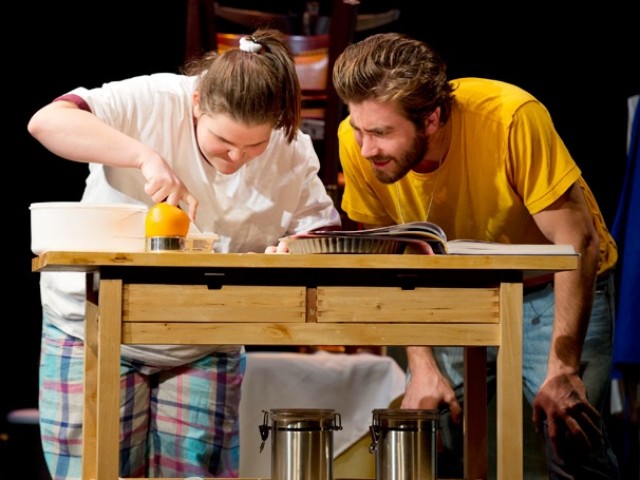
Anna (Annie Funke) and her uncle George (Jake Gyllenhaal) try to make a connection in IF THERE IS I HAVEN’T FOUND IT YET (photo by Joan Marcus)
Roundabout at Laura Pels Theatre
Harold and Miriam Steinberg Center for Theatre
111 West 46th St. between Sixth & Seventh Aves.
Tuesday – Sunday through November 25, $100
212-719-1300
www.roundabouttheatre.org
Oscar-nominated actor Jake Gyllenhaal is making his New York theater debut in Nick Payne’s If There Is I Haven’t Found It Yet, but it’s director Michael Longhurst’s staging that dominates the proceedings, for both good and bad. A hirsute Gyllenhaal (Brokeback Mountain) stars as Terry, an Irish drifter who suddenly shows up at the home of his older brother, George (Tony winner and Emmy nominee Brían F. O’Byrne), an environmentalist writing a book called How Green Are Your Tomatoes? that is taking up most of his time. George’s wife, Fiona (Michelle Gomez), is alienated by his continuing absences while also having trouble dealing with their daughter, Anna (Annie Funke), a severely overweight fifteen-year-old who is being bullied at the school where Fiona teaches. Anna soon finds a friend in her uncle, a beer-guzzling, pot-smoking ne’er-do-well who has a very different idea of parenting. Although the play sets up some interesting relationships in the first act, the second act spirals downward in a mess of clichéd dialogue and trite plot twists, leading to an obvious climax audiences will pray won’t happen but does. Longhurst, in his New York debut, teams with Tony-winning set designer Beowulf Boritt (The Scottsboro Boys) to come up with an exciting way to change scenes. As the play begins, a mountain of furniture and odds and ends are piled in the center of the stage, which is claustrophobically closed in by walls on three sides. As each new scene starts, the actors pull a chair, table, or other element out of the pile to use. However, when the scene ends, the characters angrily push or kick the chairs, tables, and even a refrigerator into an encased moat filled with water at the edge of the stage. It’s a powerful conceit, but one that never really establishes a reason other than to allow the characters to display emotions that would be better served within the constructs of the play itself. Indeed, as the audience enters the Laura Pels Theatre, a spray of rain is filling the moat, and Anna walks up to the falling water and puts her hand out to touch it. Payne and Longhurst are using the life-giving nature of water to try to establish a connection between the family’s future and the melting of the polar ice caps that George is so obsessed with, an environmental calamity that could eventually flood the world, but it’s a staging tool that ultimately drowns in its own metaphor.